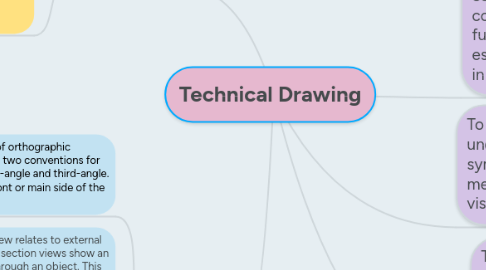Technical Drawing
by María Andrea

1. Methods
1.1. Sketching: A sketch is a quickly executed, freehand drawing that is usually not intended as a finished work.
1.2. Manual or by instrument: The basic drafting procedure is to place a piece of paper (or other material) on a smooth surface with right-angle corners and straight sides—typically a drawing board.
2. Views
2.1. Multiview: is a type of orthographic projection. There are two conventions for using multiview, first-angle and third-angle. In both cases, the front or main side of the object is the same.
2.1.1. First-angle is drawing the object sides based on where they land.
2.1.2. Third-angle is drawing the object sides based on where they are.
2.2. Section: While multiview relates to external surfaces of an object, section views show an imaginary plane cut through an object. This is often useful to show voids in an object.
2.3. Auxiliary: views utilize an additional projection plane other than the common planes in a multiview.
2.4. Patterns: sometimes called developments, show the size and shape of a flat piece of material needed for later bending or folding into a three-dimensional shape.
2.5. Exploded: It shows the components of an object slightly separated by distance or suspended in surrounding space in the case of a three-dimensional exploded diagram.
3. Technical drawing, drafting or drawing, is the act and discipline of composing drawings that visually communicate how something functions or is constructed. It is essential for communicating ideas in industry and engineering.
4. To make the drawings easier to understand, people use familiar symbols, perspectives, units of measurement, notation systems, visual styles, and page layout.
5. The need for precise communication in the preparation of a functional document distinguishes technical drawing from the expressive drawing of the visual arts.


